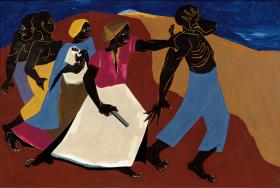1. Break the class into small discussion groups. Give each group an image of Jacob Lawrence's Forward. Have them create a list of questions that come to mind as they view this work of art. Tell them not to answer their questions but to simply determine the ways they may be able to answer them, such as using prior knowledge, doing some research on the subject or artist, looking more closely at the work of art, comparing it with another work by this artist, and so on.
2. Gather back together as a class and discuss the questions that were raised. As a group, encourage students to answer as many questions as they can based purely on the visual evidence in the painting. When necessary, share additional information on Forward with the students or have students share related prior knowledge.
Lead the students through a discussion about the value of asking questions before, during, and after looking at a work of art. Ask them to consider the ways their questions changed based on the amount of time they spent looking at the work of art:
- How were the questions you asked at the beginning of the project different from those you asked after you had viewed and discussed the work of art with your peers?
- When did your questions become more meaningful? When did they become more abstract or more subjective?
- How did those questions reflect your thinking or looking process?
Define the word metacognition, and ask students to consider ways they could apply questioning to their work in other subject areas, such as language arts or social studies. For homework, have students write a journal entry describing the process through which they came to understand the painting. They should consider:
- How did the questions help your comprehension process?
- How did the background information change your view of the work of art?
- How did you use prior knowledge to better understand the work of art?
- What is one question you would still like to ask the artist?
3. Explain that the artist chose a specific episode in the life of Harriet Tubman to represent universal themes. As a class, make a list of those themes (for example, freedom, slavery, fear, force, trust). Discuss how the artist communicates those themes using a purely visual language, such as color, pose, shape, and space. Ask:
Why might Jacob Lawrence, an African American artist, have been interested in those themes when he painted this scene in 1967?
Provide some historical information on the civil rights movement to help students understand the time period in which this object was made.
4. Have students select one of the themes from the list and write a definition of that word using the work of art as their only reference. Ask them to generate a list of questions that come to mind about the theme they have chosen. (For example, Why was slavery allowed?) Tell them to select their best questions and create a question poem. This poem consists of a list of 5–10 questions that can be serious or silly, answerable or unanswerable.
Display the students' poems alongside an enlarged image of Forward, and discuss the questions as a class.
● The teacher may use class discussion and the journal entry to assess each student’s use of questioning as a strategy for comprehending a work of art.
● The teacher may use the poem to assess each student’s ability to identify universal themes in a work of art and generate questions related to those themes.
● The teacher may evaluate poems using local rubrics to assess for clear, coherent writing with development, organization, and style appropriate to the task, audience, and purpose.
● The teacher may evaluate collaborative discussion using local rubrics to assess student preparedness, collegiality, and elaboration.
● Through discussion and writing, the teacher can evaluate the use of Forward as a document to consider interpretations of various historical perspectives as well as beliefs, practices, and traditions of different groups of people.
Underground Railroad
question poem
metacognition
copies of the focus work, journals, model poems
Forward dramatizes the life of Harriet Tubman (1820?-1913), "the Moses of her people." Born into slavery, Tubman escaped in 1849, and then repeatedly returned to the South to rescue other slaves. Jacob Lawrence relates an incident in her story with masterful economy, eliminating all but the essentials of the composition. In this painting, Tubman shepherds a small group of fugitives north to freedom. By the dark of a new moon, six barefoot figures steal warily across a bare landscape. Clutching a gun, Tubman commands center stage, her indomitable spirit expressed in the forward momentum of her body and the determined thrust of her arm that pushes her recoiling comrade onward. Others follow, their faces and gestures expressing both fear and resolution. In the context of the ongoing Civil Rights struggles of the late 1960s, Lawrence portrays the historical Tubman as a timeless example of moral courage and determination.


